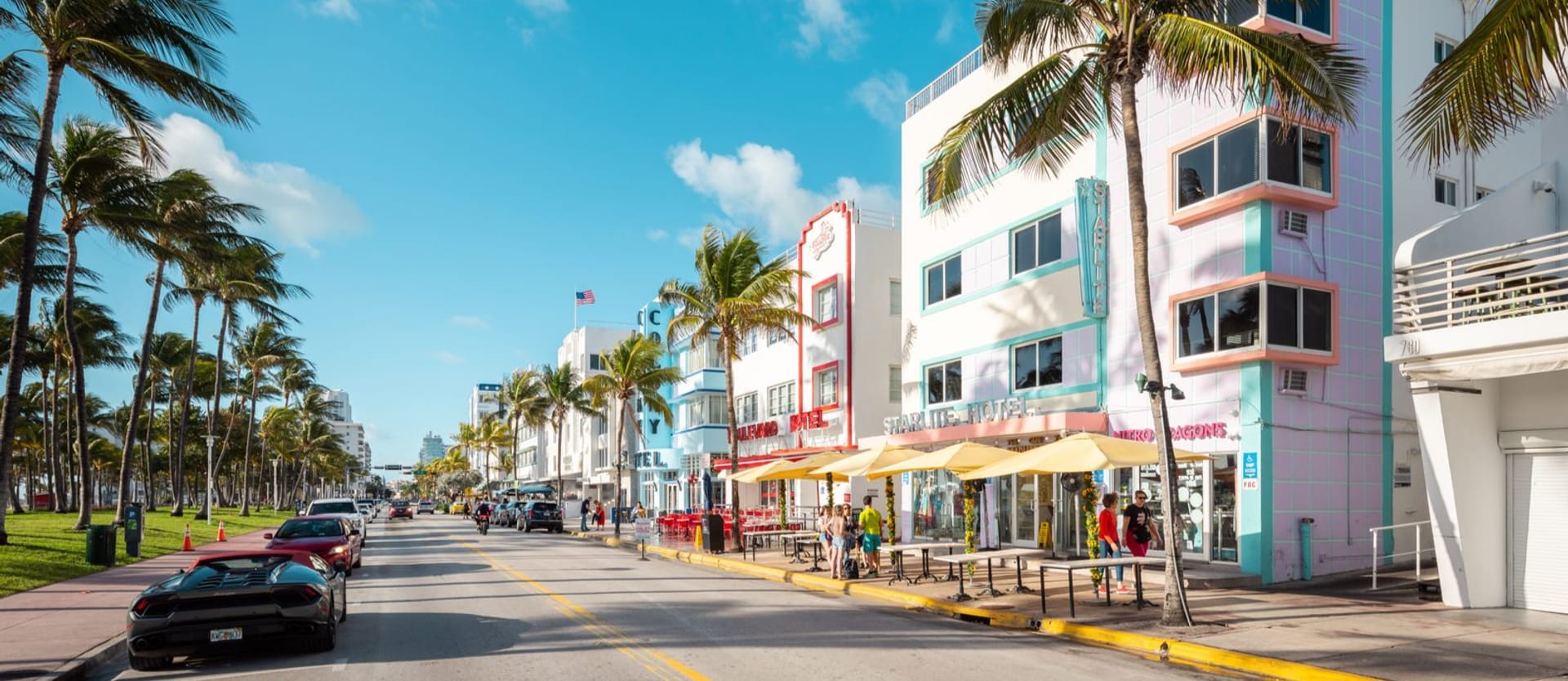Hoteliers have been stuck paying overinflated commissions to online travel agencies (OTAs) and other middlemen. OTAs have been fighting to keep data flowing between disparate systems. So, selling hotel rooms became a messy business that left many of its players unsatisfied. But as is usually the case: If there’s a problem, there will be a solution.
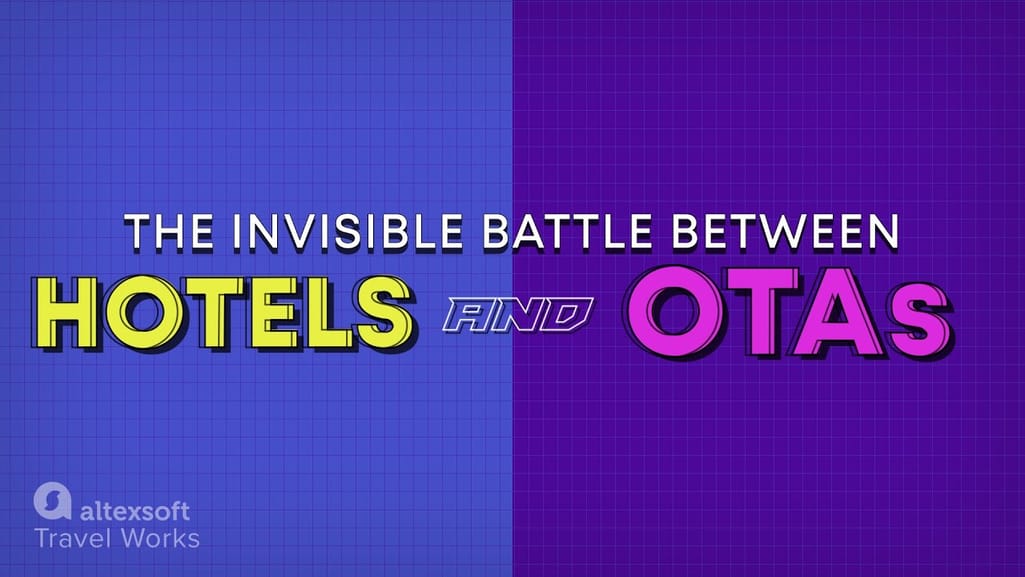

Learn more about the complex politics of hotel-OTA relationships in this video
In recent years, a few startups have sprung up to disrupt hotel distribution. They have the potential to either transform the hotel room selling model or prove themselves ineffective. For those who want to consider this new approach to hospitality distribution, here is our review of them. But first, let’s talk about how and why the problem appeared in the first place.
The current state of hotel distribution and its challenges
There are so many ways hotel rooms are sourced and sold that we created a whole infographic to untangle them. You can refer to it as we explain the situation further. Here, we will give a compact overview.
Basically, a hotel can sell its rooms two ways – directly, via its website, or indirectly. The second approach implies cooperating with a large landscape of middlemen on different stages of distribution. These include:
- Global Distribution Systems – massive old businesses like Amadeus, Sabre, and Travelport.
- Bed banks or wholesalers, buyers of rooms in bulk for contracted prices. Hotelbeds and WebBeds are the largest examples.
- Online travel agencies, those who get most of their inventory from wholesalers and GDSs, but also allow hotels to post listings via an extranet.
- Metasearch websites like Google Hotel Ads and Skyscanner where hotels can both directly and indirectly (via bedbanks and GDSs) get their rooms listed.
- Travel management companies or TMCs that power business travel by providing rooms at negotiated prices. Consider American Express GBT and BCD Travel, for example.
- Channel managers that are used by hotels to control all listings placed on all platforms.
- Different connectivity providers such as RateGain and Gimmonix that cover a variety of more niche-type services and content exchange.
Two-thirds of online hotel sales are made via OTAs, specifically two big ones – Expedia Group and Booking Holdings. As such dominating forces, they attract all other parties, who either rely on them for inventory (metasearch engines, smaller OTAs, connectivity providers, TMCs) or sell it to them (hotels, GDSs, bed banks). The connectivity and data flow between all these players make up the current distribution ecosystem. And although it developed naturally, it underwent so many changes that it no longer works well.
Here are a few problems that both suppliers (hotels and other accommodation providers) and distributors are facing today.
A pyramid of commissions
Hotels pay notoriously huge commissions to OTAs, up to 30 percent of the end booking rate. This means that their profit margins are way lower compared to direct distribution. But although this is a huge problem by itself, it’s magnified when you consider how many more intermediaries you have to pay commissions to.
As Ben Stephenson, founder and CEO of Impala, puts it, “You’ve got a PMS [property management system], and then a channel manager’s taking a cut of the booking, and then above that, a wholesaler is taking a cut, or an affiliate network is taking a cut, or a metasearch is taking a cut. Then the credit card or payments processor takes a cut and gives a kickback to one of the previous third-parties. It’s an absolute nightmare.”
This problem would be solved if an OTA had direct connections to its hotels, thus shortening the booking path. But here, the second challenge steps in.
An integration gap
Data exchange in travel and beyond is powered by pieces of code called Application Programming Interfaces or APIs. They are extremely handy and allow different software systems to fit together like puzzle pieces. In theory. Because in reality, this is a bit more complicated.
Let’s take property management systems (PMS), used by hotels for reservation and admin tasks. It’s a hotel’s main command center, from where information about rooms, prices, and amenities is shared with distributors and middlemen. When a new distributor wants to connect to a PMS for hotel inventory data, they need to establish a new API connection. For example, integrating with OPERA 5 – an undisputed leading PMS with around 2000 certified integrations and counting – may take months and requires a skilled programmer on the team. Another example from our own experience is Sabre GDS integration, which poses many challenges and requires a keen understanding of the task. Connections also tend to break for technical reasons and need to be updated.
So, if a hotel wants to connect to more providers, they’re pretty much limited to the ones already supported by their PMS or channel manager. At the same time, an OTA doesn’t have the resources to custom connect to every hotel and is forced to do so via middlemen like bed banks, reducing profit margins.
Lack of control and transparency
Although distributors can market a hotel to a wider audience, they widen the distance between a property and its guests. This means that when selling rooms to a wholesaler, a hotel has no way of knowing who the end customers are. This makes it hard to understand the audience well, determine prices, and build strong relationships with guests. Since revenue management is a crucial element of a modern hotel’s success, such a lack of control is a big disadvantage.
Airline distribution, which has been around longer than hospitality's distribution, has been trying to solve the same problem with its NDC program, which aims to replace old, nontransparent communication technologies. The hospitality industry lags behind with no formal way to drive progress. But there are several informal ways. Let’s finally talk about them.
Distribution 2.0 – making direct hotel connectivity easy
As we already established, building direct hotel-distributor integrations is complicated and time-consuming, so parties tend to plug into wholesaler inventories instead. In recent years, a few businesses, independently from one another, offered similar solutions, which revolve around the idea of a hospitality marketplace.
Basically, a hospitality marketplace is a hub for hotels and distributors to meet and integrate on simple terms and without intermediaries. When a hotel connects its PMS and CRS to the marketplace, tons of distributors and software providers get to sell inventory immediately, without signing a contract and setting up a connection with each one. HyperGuest uses the term Distribution 2.0 to explain this new model, while Impala refers to it as Open Distribution. This model's main benefits include the following.
Fast and simple integration. Using a universal API, hotels and resellers can set up a connection once and get the business running in mere days, if not sooner. A modern interface allows for low or no coding and no extra content mapping and pulls availability, rates, inventory, and content to be directly sold by resellers.
Increased margins. The whole distribution chain is replaced by one intermediary, meaning that you get to pay a single fee instead of many. In some cases, hotels get to distribute for free, and only resellers pay.
Simple contracts and payments. A hotel signs one contract and gets to sell its rooms to tons of places. Resellers also don’t need to haggle over contractual terms with each hotel separately. Using a simple dashboard, both sides can accept and negotiate prices, offer discounts, and create custom rates in minutes. No more months-long negotiation process with GDSs.
Now, let’s talk about available providers and their differences.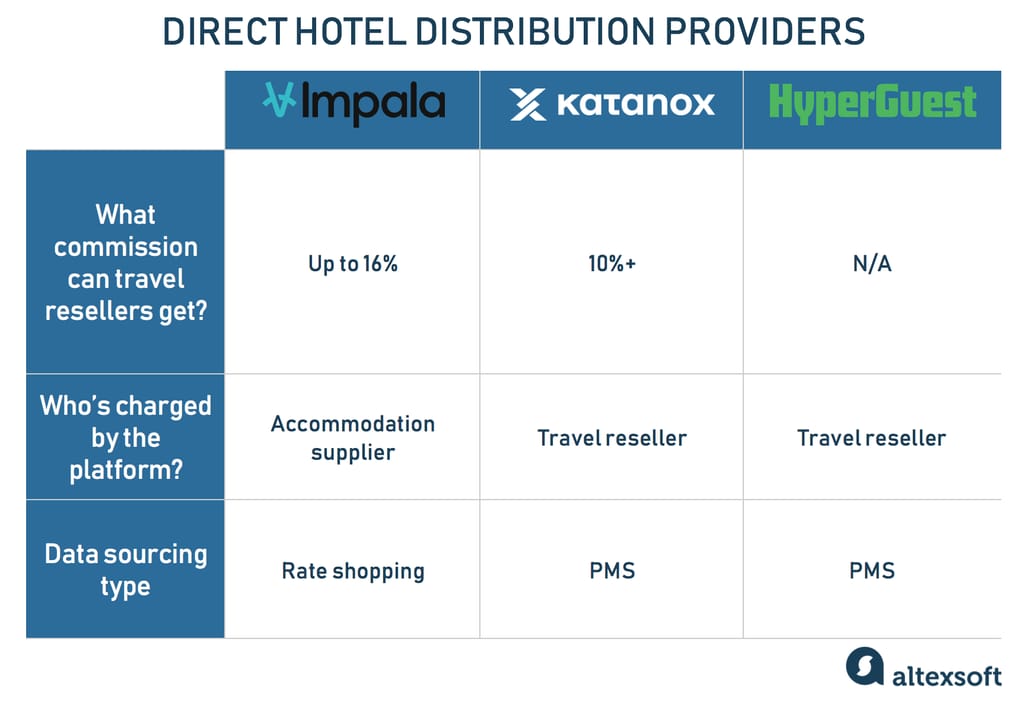
Difference between main hotel distribution disruptors
Impala – leader of the new distribution
London-based startup Impala launched in 2017 as a travel tech provider, building a PMS. After struggling with all the challenges around PMS integrations, they conceptualized a new product and in 2019, raised an $11 million Series A funding round. Just four months later Impala acquired $20 million Series B financing from former investors in Airbnb, Trivago, and Deliveroo. On top of that, they recently hired people from Airbnb, Google, and Checkout.com for leadership roles.
Impala gathers hotel information by rate shopping. This is a revenue management technique that uses smart tools to search and cross-check different sources (OTAs, brand.com websites, GDSs, etc.) for better data breadth and accuracy. Doing this, Impala helps partner hotels avoid booking fees from their PMS and channel managers. So, when the booking is requested via Impala, the hotel receives it via email, bypassing middlemen.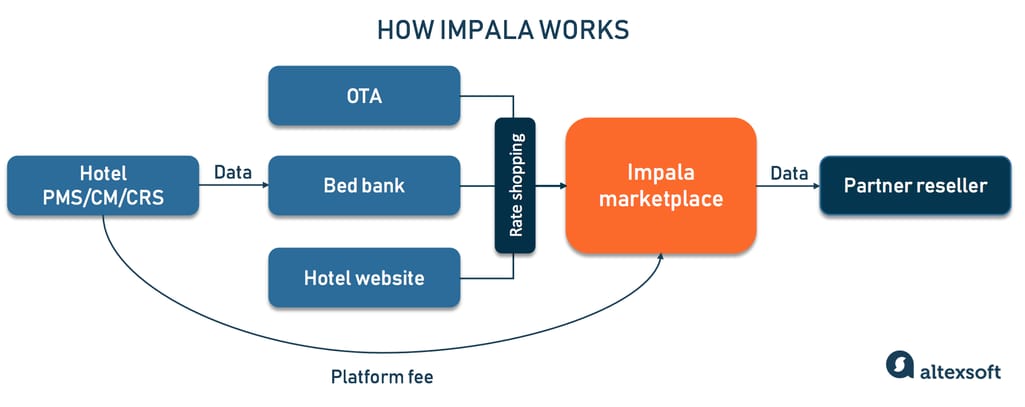
How Impala connects accommodation providers and resellers
Using this method, Impala makes the following accommodation data available via their API:
- availability,
- rates,
- hotel distribution,
- hotel amenities,
- room types along with their amenities, occupancy, and prices.
Hotels can request changes to the content via a special form on their dashboard.
Impala also has an API for travel technology companies that want to access hotel content – Impala Stay. They can source content from such PMSs as Oracle Hospitality, Suite8, Guestline, Mews, and Clock PMS. Though they are currently not accepting new customers, keep checking on them until they do.
Partner network. Today, among Impala’s largest hotel partners are Iberostar, NH hotels, Six Senses, and more. Their distribution partners include Agoda, Sidehide, and BYHOURS among the others.
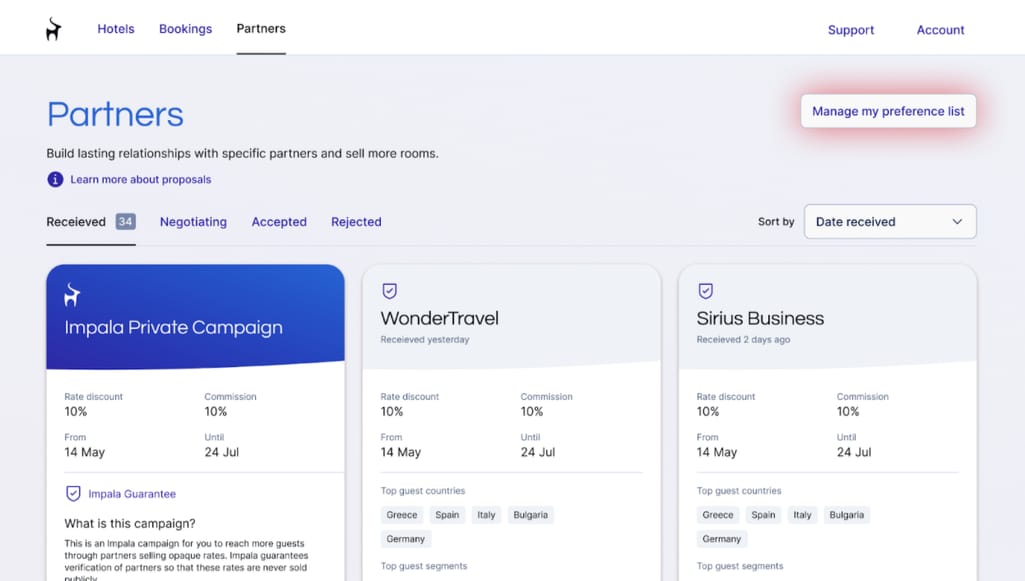
Impala partner dashboard provides a neat overview of all the relationships the business built on the platform Source: Impala
Pricing and commissions. On Impala, hotels can sell their rooms at the available public rate for a commission agreed on with each reseller (on average, 9 percent). There’s no integration fee and charging starts after the first booking. Impala collects a “small percentage” from hotels per booking.
Integration for hotels. Impala does all the hard work and promises to get the hotel live in under 48 hours. All rates, availability, and content are gathered via public sources, and they’re constantly updated. A hotel can also adjust the content on request.
Integration for resellers. For a room seller to integrate, they can sign up and explore the platform without any coding knowledge and get their API keys there. The rest can be set up with the help of Impala API docs. At the same time, if room resellers want to see a particular hotel on the platform, they can request Impala to add it.
Katanox – a channel manager with a twist
Another startup is Katanox, founded in 2020 in Amsterdam. In early 2021, they received €300 thousand in funding, which powered their product.
Unlike Impala, Katanox sources data directly from PMSs, so hotels can expect that all changes they make in the PMS will appear on the platform. At the same time, if a hotel wants to change content such as pictures for resellers, it can do so via the dashboard.
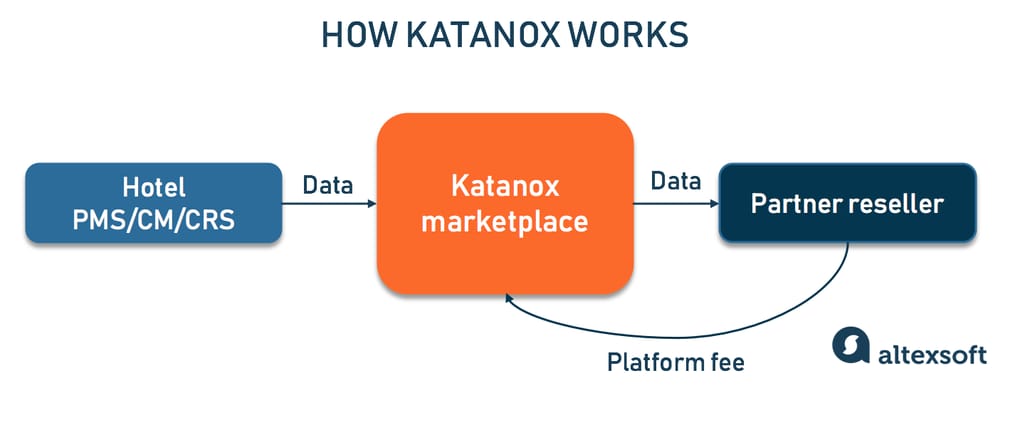
How Katanox connects accommodation providers and resellers
A Katanox API provides access to such hotel content as:
- availability,
- rates,
- inventory,
- unit (room or bed) type,
- available properties
Partner network. Katanox allows resellers to connect not only to hotels directly, but also to other accommodation suppliers, for example, Cloudbeds, Casai, and Sonder, sharing their huge inventories via a single API. At the same time, Katanox’s partnerships with Oracle Hospitality, Mews, and others allows users of these PMSs to sell to many distributors in a few clicks, operating almost like a channel manager.
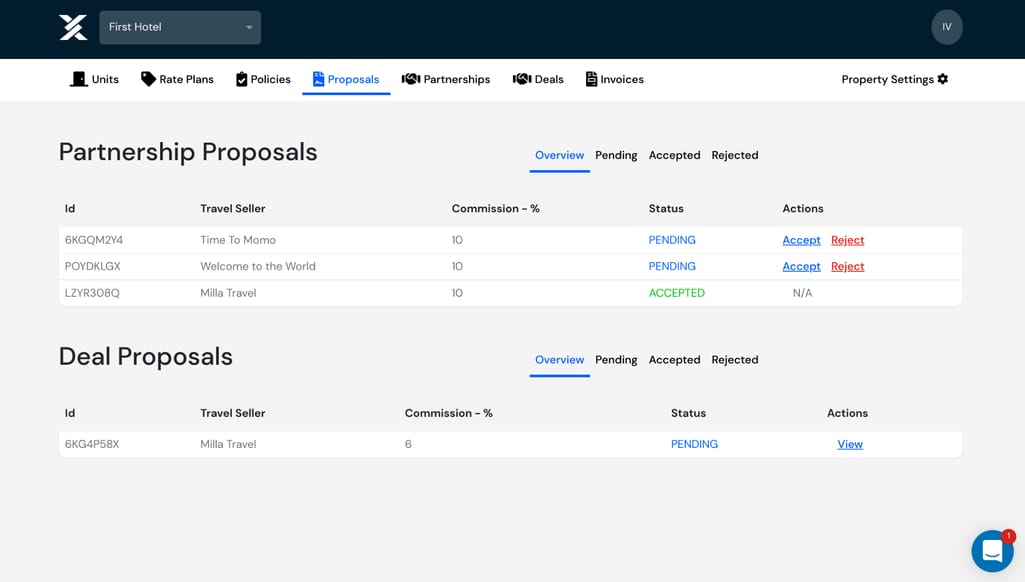
The compact deal dashboard from Katanox
Pricing and commissions. Katanox charges a small commission from travel resellers instead of suppliers. The only fee hotels pay is a standard 10 percent commission to the reseller per booking, though they can increase it per individual agreement.
Integration for hotels. Hotels can integrate with Katanox via Mews, Cloudbeds, Clocks, or Apaleo PMSs. A hotel can set up a call with a representative that can guide them through the process or use instructional videos. The whole deal won’t take more than 20 minutes.
Integration for resellers. After signing up, a reseller can retrieve a sandbox API key. Within 48 hours, while the integration is being verified, a reseller will be able to go live. Learn how to search and book accommodations in Katanox API docs. They’ve also recently announced an official SDK for PHP and plan to add other languages soon.
HyperGuest – not only hotel distribution
Launched in 2020 in Israel, HyperGuest has received a seed round of $5 million the same year and by February 2022 acquired over 3000 hoteliers, 5000+ alternative accommodation, and over 200 distribution partners.
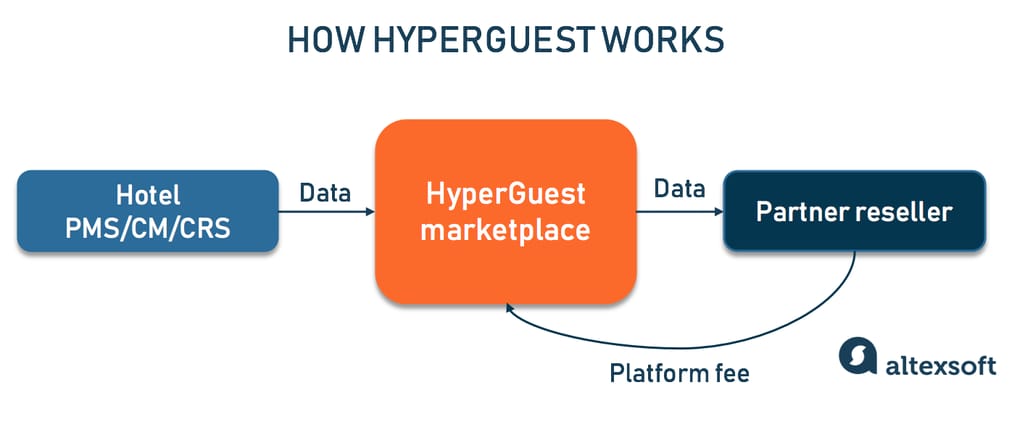
How HyperGuest connects accommodation providers and resellers
HyperGuest also collects data directly from the source – hotel PMSs, CRSs, or channel managers. All data is multilingual and up to date. It includes:
- availability,
- rates,
- inventory,
- property and room information, including pictures and descriptions.
HyperGuest isn’t limited to connecting accommodations with resellers; it’s also a platform for connecting any travel product suppliers (tours, museums, transportation, events) with any travel technology products (revenue management tools, booking engines, etc.)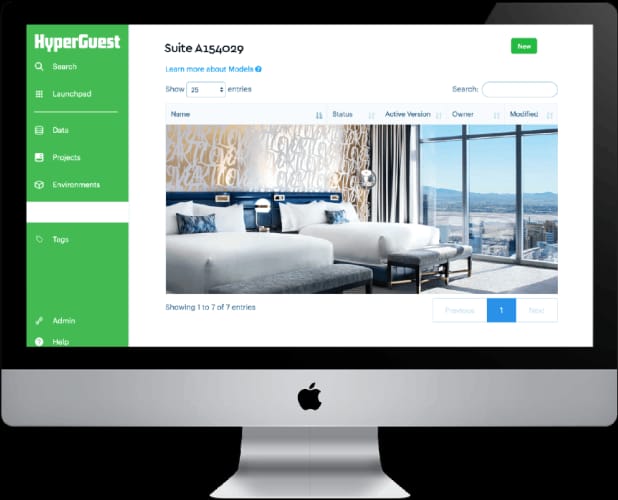
HyperGuest interface
Partner network. The product is growing fast with some of the most impressive partners including RateGain, Your Rentals, DerbySoft, Sherwood Resorts & Hotels, SiteMinder, Amadeus, and many more. Have a look at their news section as it’s being updated all the time.
Pricing and commissions. HyperGuest doesn’t get a commission from accommodation suppliers. At the same time, it uses an à la carte approach when pricing its reseller partners, tailoring the proposition to each client.
Integration for hotels and resellers. To access the HyperGuest platform, both sides (accommodation providers and travel resellers) must follow the same path. They sign a digital contract and sign up with an account. Then, they must send an email to HyperGuest’s integration team with a copy to the contact managing their PMS, CRS, CM, or other booking software. They promise a zero-coding integration experience that will take a few minutes.
Reinventing hospitality is yet to happen
As you can see, the functionality of such providers is similar to channel managers, which is providing one place to connect with many partners. The principal difference is that despite being another link in the booking flow, Open Distribution players eliminate all links and provide seamless integration regardless of what PMS or booking software the company uses. Yet there are products in the domain that try to solve the same problem differently, each in its own way.
For example, products like Apaleo, Hapi Cloud, Journera, Channex, or Roibos are solving the connectivity problems with innovative technologies and APIs, ultimately resulting in faster time to market. They’re all meant to unbind hotels from their legacy systems and resellers – from GDSs, and make it easy to integrate with the huge world of travel tech products.
Impala, HyperGuest, Katanox, and other disruptors are gaining traction. But will they ever replace GDSs or channel managers? Change in the travel industry happens slowly, so claiming that Distribution 2.0 is the new way of doing business wouldn’t be totally accurate. Either way, we’re looking forward to seeing where these innovations take us. For now, you’re free to explore them and see whether they truly represent an improvement in your hotel distribution processes.

Maryna is a passionate writer with a talent for simplifying complex topics for readers of all backgrounds. With 7 years of experience writing about travel technology, she is well-versed in the field. Outside of her professional writing, she enjoys reading, video games, and fashion.
Want to write an article for our blog? Read our requirements and guidelines to become a contributor.
